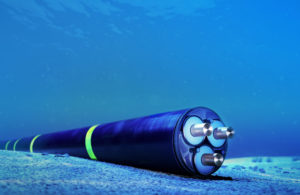All About Subsea Electrical Transmissions

Solar, EVs and energy storage are disrupting our energy supplies.
But there’s another disruption I haven’t addressed. It has to do with electrical transmission.
One of the most exciting developments in renewable energy is offshore wind. Up until a few years ago, it was harnessed mostly in northern Europe.
But that’s rapidly changing. Today, California and a dozen East Coast states from Maine to South Carolina are embracing offshore wind.
However, offshore wind turbines share a common problem with offshore oil and gas platforms. All require undersea electrical transmission lines.
Oil and gas platforms need vast amounts of electricity to operate. Some use diesel generators. If they are close enough to shore, a power cable can run directly to the platform. But the farther out the platform is, the higher the transmission voltage has to be. And each platform needs its own dedicated power line.
Today, those platforms are fed either from substations on the surface called “floaters” or directly from shore. When the weather gets bad, some platforms are shut down and the power is abruptly switched off.
If a complex oil drilling platform’s power is suddenly turned off, various pumps and other equipment could malfunction and cause a fire or explosion.
It’s much better to shut down the platform in an orderly fashion.
Wind turbines suffer from a similar problem. But they aren’t using power… they’re generating it.
Without power lines connecting every turbine to the onshore power grid, wind turbines are useless.
But what if there was a way to solve the problem that plagues both wind turbines and offshore platforms?
Under the Sea
What we need is an underwater electrical transmission and distribution network on the sea floor. And these components have to work at depths of up to 10,000 feet.
It sounds impossible. But today, companies like General Electric (NYSE: GE) and ABB Limited (NYSE: ABB) are designing just that.
New transformers and switch gear are being designed and tested. These will move electrical transmission, switching and distribution of power for oil platforms to the ocean floor.
Those same components will collect power from individual wind turbines. That power will be sent to onshore grids for further transmission and distribution.
In addition to moving power to the sea floor, undersea transformers will allow power to move much greater distances. This means that platforms operating 200 miles off the coast of Louisiana and Texas can access shore power.
That removes loud diesel generators from platforms. It also eliminates costly fuel resupply trips from the mainland.
Status Update
So what is the status of subsea power?
ABB seems to be ahead of its competitors. It announced a subsea power system that can reliably supply up to 100 megawatts of power in any undersea environment of around 9,800 feet deep.
According to ABB, its system will need “little or no maintenance for up to 30 years following deployment.” That makes it a game-changer for offshore platforms.
ABB also conducted a study that determined its new technology could save $500 million in capital expenditures if eight pumps or compressors are connected to the system.
It claims customers who deploy the new system could see savings of 30% to 40%. That, combined with a 30-year reliability expectation, makes these deployments no-brainers for both new and existing platforms.
And offshore wind expands the potential customer base even further. It’s another exciting 21st century energy disruption.
Good investing,
Dave






